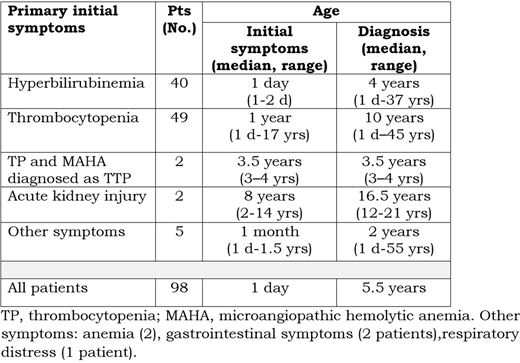Recognition of hereditary disorders in newborn infants and early childhood is critical for anticipating and preventing adverse outcomes. Hereditary thrombotic thrombocytopenic purpura (HTTP) is caused by biallelicADAMTS13mutations. Absence of ADAMTS13 results in circulation of ultra-large von Willebrand factor multimers which increase risk for microvascular thrombosis, causing severe thrombocytopenia and microangiopathic hemolytic anemia. Extreme hemolysis with hyperbilirubinemia occurs in 42-45% of newborn infants (New Engl J Med2019;381:3653). Stroke occurs in 25-31% of patients with HTTP; the median age is 19 years; 22% of strokes occur before age 10 years (Blood Advances2019;3:3973). When HTTP is recognized, treatment with plasma infusion is simple and effective. Methods. To document the [1] relative frequency of initial symptoms, [2] age of initial symptoms and [3] age of diagnosis, we systematically searched for all case reports of patients with hereditary TTP whose diagnosis was confirmed by ADAMTS13 activity <10% and biallelicADAMTS13mutations, from 2001 (when ADAMTS13 was first described) to March 20, 2020 (original literature search described inBlood Advances2019;3:3973). We identified 80 articles describing 180 patients. Because the objective of most reports was to describe newADAMTS13mutations, we believe that the clinical data are not biased for exceptional cases. For this study we selected the the 98 patients <18 years old who had known age of initial symptoms and their description, and also their age at the time of diagnosis of HTTP. Results: The predominant initial symptoms were severe indirect hyperbilirubinemia (caused by hemolysis) at birth (40 [41%] patients) and thrombocytopenia (49 [50%] patients) [Table]. Even though thrombocytopenia was often associated with microangiopathic hemolytic anemia, HTTP was not diagnosed in these 49 patients. In 2 patients who had severe thrombocytopenia and microangiopathic hemolytic anemia as their initial symptoms at ages 3 and 4 years, TTP was diagnosed. Other initial symptoms were severe anemia (2 patients), gastrointestinal symptoms of vomiting and diarrhea (2 patients), and respiratory distress (1 patient). Although initial symptoms were present at birth in 57 (58%) patients, suspicion and recognition of HTTP did not occur until many months or years after the initial symptoms. The median age of initial symptoms was the first day after birth; the median age of diagnosis was 5.5 years. Future plans: Simpler access and more rapid reporting of results have increased familiarity with testing for ADAMTS13 activity. We are currently working with neonatology/perinatology to develop appropriate criteria (bilirubin level, platelet count) for ordering ADAMTS13 activity measurements in newborn infants, with neurology to recommend ADAMTS13 activity measurements in children and young adults with stroke, and with pediatric hematology to recommend ADAMTS13 measurements in children who are diagnosed with immune thrombocytopenia (ITP) associated with evidence for DAT negative hemolysis, including the presence of schistocytes on the peripheral blood smear. Conclusions: Simpler access to ADAMTS13 activity measurements increases familiarity with this test and provides the opportunity for much earlier diagnosis of HTTP in infants and children. With earlier recognition of HTTP, initiation of prophylactic plasma infusions can decrease children's morbidity and mortality. Future availability of recombinant ADAMTS13 will make prophylactic treatment more convenient and effective.
No relevant conflicts of interest to declare.
Author notes
Asterisk with author names denotes non-ASH members.


This feature is available to Subscribers Only
Sign In or Create an Account Close Modal